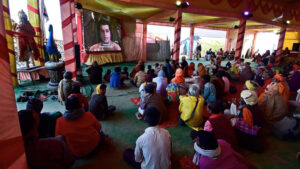JANUARY 22, 2024

For many Hindus, the Ramayana is simply the divine truth revealed to Valmiki. But while the epic is familiar and beloved across India and Southeast Asia, Ram has not been a widely worshipped figure in eastern or southern India. Hindus in West Bengal, Tamil Nadu and Kerala prayed to goddesses, or to local deities, or other avatars like Krishna. Ram-bhakti was first confined to Vaishnava sects and Ram was revered as an incarnation and a human ideal, rather than placed in a temple.
Renderings of the Ramayana have varied by region, shifted emphasis depending on the bard or storyteller. While Tulsidas wrote the Ramcharitmanas that north Indians know, versions by Krittibas, Kampan and Ezhuthachan are the primary texts in east and south India.
The Ramayana has been rendered into all languages in south India, starting with the highly devotional Iramavataram by Kampan in the 12th century. “The art form of Ramayana Koothu has been practised in temples since the times of the Zamorin in Malabar. The story of Ram is very popular in South India,” says professor N Ganesh, chair of Kerala Council for Historical Research, “but it has not translated into mass worship.”
Tamil Nadu has a crowded religious arena, with folk religion revolving around warrior-gods. “Each region has different folk gods, family deities, and customs. For example, Sudalaimadan, Isakkiamman are worshipped in southern Tamil Nadu, and Annanmar in the Kongu region, says A Sivasubramanian, author and folklorist. Also, Shaivism has been dominant, with deities like Murugan — considered by some to be an enduring tribal icon — leaving Ram in the shadows.
Even the Tamil Vaishnavite movement celebrated Ram only as an exception, largely choosing Krishna in the Bhakti movement of the 7th century. “Temples for Rama were built during the period of the later Cholas, Pandyas, and Vijayanagara empires. Most of the bronze idols found in Tamil Nadu were related to Krishna,” says Tamil scholar and anthropologist Tho Paramasivan in his book Deivangalum Panpattu Asaivugalum (Deities and Cultural Movements).
Meanwhile in Kerala, Krishna became popular precisely to overcome the lack of an effervescent bhakti cult in the region, says writer, critic and Ramayana scholar Sunil P Ilayidom. The Ramayana’s sacred status made Ram a more noble, distant figure than Krishna, whose mischief and adventure brought him closer to people.
Another reason for Ram’s low-key presence in Kerala is the persistence of Dravidian traditions like Bhagwati kavvus, or goddess cults. “While gotra traditions became Aryanised in north India by the 9th century BC, that didn’t happen in Kerala,” says Ilayidom. In Tamil Nadu again, female deities are more significant, there is a culture of worship around Draupadi of the Mahabharata.
In Bengal too, Ram has had ‘god like’ status as the first human avatar of Vishnu, but was rarely worshipped in a temple, says mythologist Nrishinghaparasad Bhaduri. “Chaitanya Dev (the 15th century Vaishnava saint) asked his followers to observe Ramnabami, but the majority of Bengal follows the Shakti tradition, idolising the goddess in various forms,” he says.
At odds with identity and ideology
In Tamil Nadu, Ram being perceived as a prince was the reason subaltern groups did not celebrate him in their stories, says G Stephen, a folklorist and retired professor from the Manonmaniam Sundaranar University in Tirunelveli. Artistes from the north introduced Ramayana stories using shadow puppetry and performance, he says.
Ram’s association with Brahminical and Kshatriya communities also accounts for his low visibility in Kerala, says the critic and commentator A Jayashankar.
He points out that the social reformer and sage Sri Narayana Guru established Subramanya temples across Kerala, signalling the subaltern and Dravidian affiliations of the large and emergent Ezhava community. Identity politics and religious intensity around Ram acquired a sharp edge in modern India. In Tamil Nadu, the influential and iconoclastic ‘Periyar’-led movement cast the Ramayana and its characters as emblematic of Sanatana Dharma, interpreted as the root of caste hierarchy. Periyar’s Ramayana Pathirangal was published in 1930. It took verses from Valmiki’s Ramayana on Ram killing Shambuka for being a Shudra who performed tapas.
“Periyar cast the Ramayana as an Aryan vs Dravidian battle, saying that the epic was against Dravidians, and portraying Ravan as a Tamil. And so, a generation has grown up in Tamil Nadu since the 1950s without reading the Ramayana,” says literary critic K Panjangam.
“Ram has been referred to as ‘purushottam’ or the best among men, which makes him human,” says West Bengal education minister Bratya Basu, who is also a playwright and an actor. “Everyone in Bengal has been reading or hearing the Ramayana for thousands of years but he has not been made a part of history or venerated through idols.” This changed in the early 90s when the temple movement peaked, he says. “Mahatma Gandhi had also made an ideal out of Ram in exile, his austerity, his quest for truth. And yet, Ram was never formally worshipped, even during an onslaught of Islamic aggression,” says Basu.
Is the tide turning?
Religious practices and identities are fluid. Traditions are not set in stone; shifts in power, media effects, demographic and cultural transformations can make and unmake idols. The Doordarshan serialisation of the Ramayana in the late 1980s was a phenomenon like no other. It drew an estimated 80mn viewers every week, many of whom treated it as a religious experience. Despite all the diversity in Ramayana tradition across India, this rendition, based on the Ramcharitmanas, found an unprecedented authority, scholars have found. At the same time, the Ram Janmabhoomi movement focused on the disputed shrine in Ayodhya also created a new Ram iconography, trying to fuse it with the entire Hindu community and the nation itself, insisting that “rashtra ki shakti” lay in “Ram ki bhakti”. Today, that goal has been achieved.
But the Ramayana has long played a part in India’s political imagination, since much before the Sangh Parivar came into the picture. Scholars like Sheldon Pollock have argued that Ram worship was institutionalised after the 12th century by dynasties across India, who found its lessons on divine kingship and the battle between ideal protectors of purity and evil deviants useful in a time of foreign invasions.
So will the new Ram Mandir in Ayodhya set off new currents of faith and worship across India? There have always been receptive groups of Ram believers, even in regions where the mainstream prays to other gods.
Ram worship has indeed become more visible in Bengal, particularly among the north Indians who settled there over the last century. Hanuman temples are common in places where most people are not Bengalis, and many of them have turned to Ram worship, says a sociologist.
In Tamil Nadu too, there are Kamban Kazhagam groups in many cities, dedicated to the epic, and Ram has a separate sannidhi in every Vishnu temple, says Vaishnavite scholar D Gnanasundaram.
Religious energies and rituals around Ram have picked up in Kerala as well. KS Radhakrishnan, former vice-chancellor of the Sree Sankara Sanskrit University, asserts that Ram is second to none there: “No other god is worshipped for 30 days in the Malayalam month of Karkidakam, traditionally regarded as the toughest month because of torrential rain. The Ramayana is also recited when someone dies. It means that Ram is present in the life and death of every Hindu in Kerala.”
Courtesy: TOI / PTI

































































































